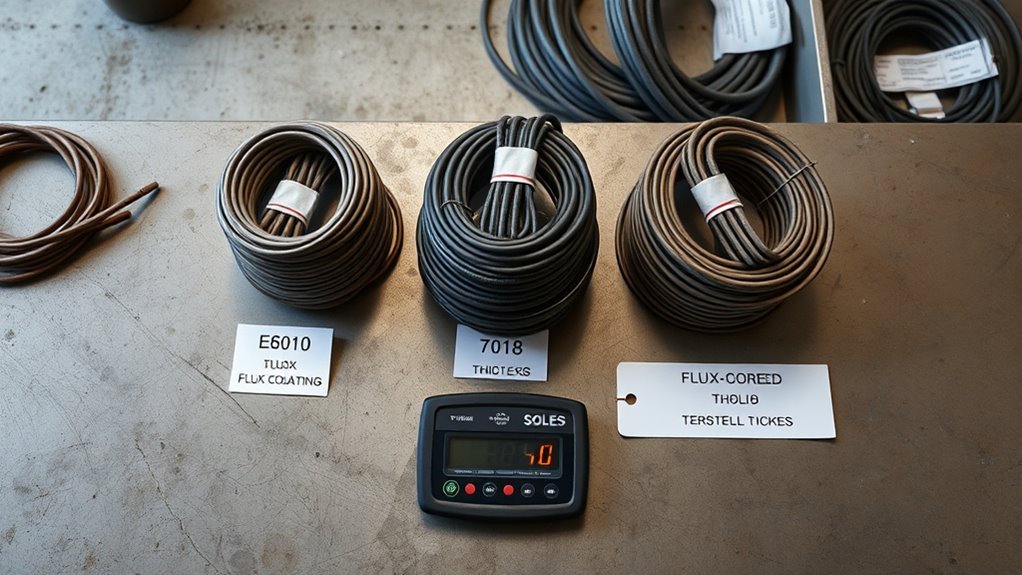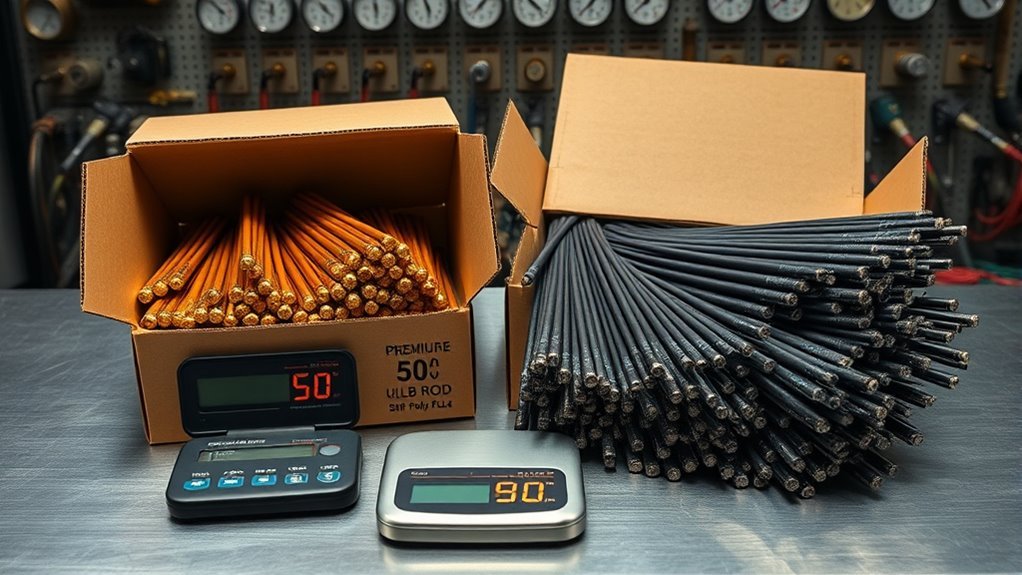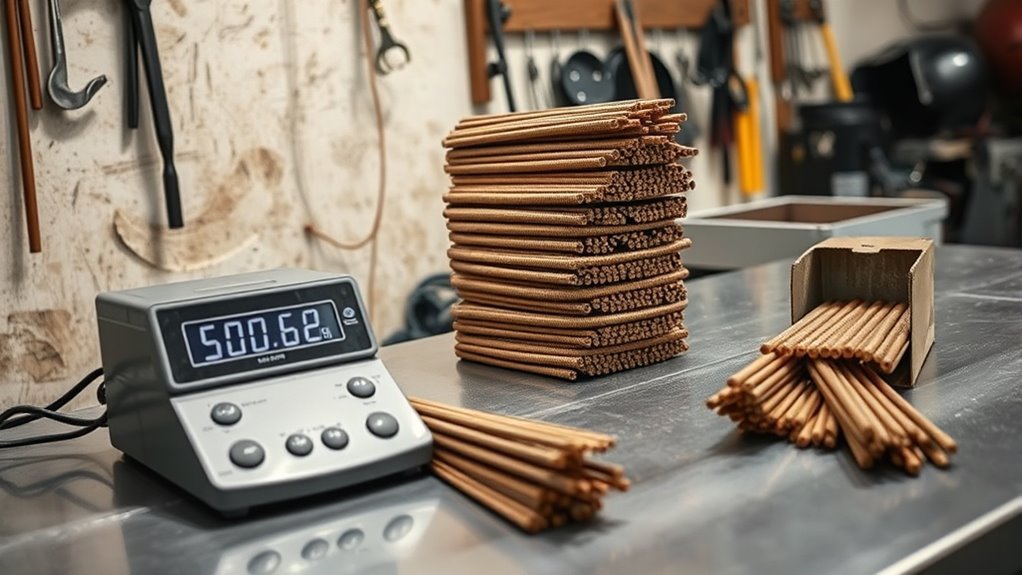You can expect to pay roughly $188 to $304 for a 50 lb can of common welding rods, depending on type, brand, and packaging. Cheaper 7018 or E6010 options run toward the lower end, while premium or specialty rods (moly, RG60, Excalibur) hit the top. Brand premiums, single‑can vs multi‑pack formats, and moisture‑resistant packaging affect cost. Buy in bulk or watch promotions to cut price, and keep reading for tips on choosing the right rod and where to buy.
Typical Price Range for 50 Lb Welding Rods by Type

Price matters when you’re buying a 50 lb can of stick electrodes, and costs vary by alloy and performance; expect prices roughly between $188 and $304.00.
Price matters when buying a 50 lb can of stick electrodes — expect roughly $188 to $304 depending on alloy and performance
You’ll find Lincoln IronArc 7018 MR near $284, while Lincoln Excalibur 7018 MR sits around $294, and premium variants like 7018-1 MR or 7018 XMR hit about $304 for 50 lbs.
If you want lower outlay, discounted packs—three 10 lb cans of Excalibur 7018-1 MR—drop to $188 from $198.30.
When you compare welding rod types, factor in strength, usability, and storage needs since those influence real cost per weld.
Watch for pricing fluctuations tied to brand, formulation, and bundle sizing so you can buy smart.
Cost Comparison: E6010, 7018, and Flux-Cored Rods

While choosing a rod you’ll balance performance against spend. Note that Lincoln’s E6010 and 7018 options—and comparable flux-cored wires—cluster in a similar price band for 50 lb cans, roughly $284–$304.00.
You’ll find E6010 advantages for root-pass pipe work at about $294 per 50 lb can; it penetrates well and controls the arc for positional welding. For general fabrication and pressure piping, 7018 applications shine — Lincoln Excalibur 7018 MR lists near $294, IronArc 7018 MR at about $284, and Excalibur 7018-1 MR at roughly $304 for improved coating integrity.
Flux-cored equivalents sit in the same band depending on chemistry and performance. Shop by application needs, then pick the rod that meets mechanical specs within your budget.
Premium and Specialty Rods: RG60 and Moly-Alloy Options

When you look at RG60, note its moly-alloy chemistry, high silicon and manganese that give flux-free brazing and high tensile strength for low-carbon and low-alloy steels.
Consider how moly-alloy performance benefits—stronger joints, cleaner process, AWS A5.2 conformity—match your repair or fabrication needs.
Finally, weigh the premium cost of a 50 lb box against the value of reduced labor, fewer consumables, and application-critical reliability.
RG60 Properties Overview
Think of RG60 as your go-to moly-alloy rod when you need high-strength gas-brazed joints on low-carbon or low-alloy steels.
You’ll appreciate its high silicon and manganese content that removes the need for flux, speeding setup and trimming consumable costs while keeping joint strength reliable for welding applications like repair and fabrication.
RG60 meets AWS A5.2 standards and comes embossed on both ends for quick ID.
- High tensile strength: suitable for demanding service where joint strength matters.
- Flux-free brazing: lowers prep time and material costs.
- 50 lb box: convenient for storage, transport, and jobsite handling.
- Standards-compliant: quality you can specify confidently.
Moly-Alloy Performance Benefits
Because moly-alloy rods like RG60 combine high silicon and manganese with molybdenum, they give you flux-free gas brazing that cuts prep time and consumable costs while delivering the tensile strength needed for demanding repairs and fabrications.
You’ll appreciate moly alloy advantages when you’re working on low-carbon or low-alloy steels — RG60 meets AWS A5.2, so you get consistent, professional results without extra flux handling.
That reliability boosts welding efficiency: fewer interruptions, faster cycle times, and reduced post-cleaning.
A 50 lb box lets you buy in bulk, lower per-pound cost, simplify inventory, and avoid frequent reorders.
For repair and fabrication work that needs strong joints, RG60 offers a practical, cost-conscious option that balances performance and overhead.
Cost Versus Application
Following the performance benefits of moly-alloy rods like RG60, you’ll want to weigh those gains against their price to decide if they’re the right fit for your projects.
You’ll compare premium options (Lincoln Excalibur ~ $284–$304 per 50 lbs) and specialty moly-alloy rods whose prices vary with tensile specs.
Focus on cost efficiency and application suitability: sometimes higher upfront cost pays back via reduced rework, eliminated flux, or better joint strength in critical industries.
- Assess duty: match rod strength to expected loads to avoid overpaying for unnecessary capacity.
- Calculate lifecycle cost: include downtime, rework, and consumables when judging cost efficiency.
- Check coating and low-hydrogen specs for application suitability.
- Buy by project needs, not brand alone.
Brand and Packaging Effects on Price

You’ll notice brand premiums can add $10–$30 or more per 50 lb can, with Lincoln Excalibur models sitting near the top and IronArc offering a lower-cost alternative.
Compare that to packaging choices: a single 50 lb Easy Open Can often carries a different per-pound price than three 10 lb cans or boxed bulk, so unit pricing matters.
Focus on required performance (low-hydrogen specs, specialty alloys) versus per-pound savings to decide where paying up makes sense.
Brand Premium Vs Value
When you weigh brand premium against value options, consider that recognized names like Lincoln Electric command higher prices because they back proven performance, tighter specs, and convenience features—examples include the Lincoln Excalibur 7018 MR at about $294 for a 50 lb can versus lower-priced alternatives.
You’ll judge trade-offs by job criticality, budget, and how brand loyalty shapes your price perception.
- Performance: premium rods have tighter chemistry and low-hydrogen specs, reducing rework risk on structural jobs.
- Moisture control: improved coatings cut moisture pickup, extending shelf life and lowering hidden costs.
- Convenience: user-friendly packaging and cans save time on site handling.
- Cost strategy: buy premium for critical welds; choose value brands for noncritical, cost-sensitive tasks.
Can Vs Boxed Packaging
Although cans usually cost more per pound up front, they can save you time and money on-site by keeping rods drier and easier to handle than boxed packs, especially on jobs where moisture control and quick access matter.
You’ll pay a premium for brand and packaging: Lincoln Electric’s Excalibur 7018 MR lists higher than IronArc, and a 3-pack of 10-lb cans can be priced differently than a single 50-lb boxed SKU.
Choose can packaging when you need moisture resistance, quick dispensing, and minimal reconditioning—it reduces downtime and scrap.
Pick boxed packaging if initial cost per pound and bulk storage are your priority and you can control humidity.
Match packaging to job size, environment, and rod specs to optimize cost-effectiveness.
Where to Buy: Retailers, Distributors, and Online Marketplaces

Finding the right place to buy 50 lbs of welding rod comes down to balancing price, availability, and convenience. You’ll want to evaluate welding safety and proper rod storage when choosing retailers — cans from Lincoln Electric or Excalibur 7018 MR are common choices near $284–$304 per 50 lb can. Check stock online or call customer service before driving.
- Lincoln Electric and manufacturer stores — reliable inventory, brand-specific options, in-person help.
- Local welding supply distributors — good for contractors, sometimes faster restock and advice.
- Online welding specialty sites — detailed specs, easy comparisons, occasional promo codes.
- Marketplaces like Amazon — convenience and delivery, but verify seller and stock before ordering.
Bulk Buying, Discounts, and Supplier Pricing Strategies
Because buying in volume usually lowers your cost per pound, bulk purchasing is a smart move if you run a shop or handle recurring projects — suppliers commonly cut unit prices as order size rises or run seasonal promotions that let you stock up at a discount. You’ll see tiered pricing and product-specific differences (for example, comparable 50 lb cans can vary in price), so track per-pound costs and promotions. Build supplier relationships to gain better terms, faster restock, and negotiated discounts. Use bulk purchasing benefits to plan inventory and reduce per-job costs without overstocking. Compare tiers, watch seasonal sales, and document prices to time purchases.
| Quantity Tier | Unit Price | Notes |
|---|---|---|
| 1 can (50 lb) | $294–$304 | Product variance |
| 5–10 cans | lower | Tiered discount |
| Seasonal promo | lowest | Stock-up opportunity |
Financing and Leasing Options for Welding Supplies
Buying in volume lowers your per-pound cost, but financing and leasing give you another way to manage cash flow and keep 50 lb cans of welding rod on hand without tying up capital.
You’ll find quick financing options like Clicklease that approve in seconds after a ~4-minute application, offering real approval without a hard credit pull. Lease payments can be structured to suit seasonal demand, and may offer tax advantages, so weigh financing benefits against outright purchase.
- Choose short-term leases for immediate stock replenishment and predictable monthly costs.
- Use longer leases to spread capital expenses while preserving working capital.
- Confirm end-of-lease options: return, buyout, or renew.
- Track tax treatment and document payments for potential deductions.
How Usage Needs Influence Which 50 Lb Rod to Buy
Match the rod to the job and your budget: the metal you’re welding, the joint position, and the environment dictate which 50 lb can you should buy.
You’ll pick electrode selection based on material and task — E6010 types like Fleetweld® 5P+ suit root passes on pipe, while Excalibur 7018 MR fits high-tensile work in power generation or shipbuilding.
Consider welding techniques: position welding needs low-spatter, easy-control rods; flat work can use heavier, higher-deposition electrodes.
Account for amperage and power source — a 3.2 mm Fleetweld® 5P+ runs DC+ 75–135 A, so ascertain compatibility.
If surfaces are dirty or painted, choose a rod rated for poor conditions.
Balance upfront cost (some 50 lb packs run ~$284–$294) against performance and rework risk.
Tips to Save Money Without Sacrificing Quality
When you need to lower welding costs without cutting quality, compare brands and formats closely — a 50 lb pail of Lincoln Excalibur 7018 MR runs about $294 while a similar Lincoln IronArc 7018 MR can be found near $284.
Multi-pack or 10 lb can options (e.g., Excalibur 7018-1 MR (3) 10 lb) may reduce per-pound prices. Use these practical steps to save money while keeping performance:
- Buy bulk or multi-pack cans to lower per-pound cost and reduce frequent ordering.
- Pick rods with low moisture pickup (Excalibur claims ~60% less) to cut defects and rework.
- Explore financing like Clicklease to spread upfront cost without a hard credit pull.
- Optimize rod storage and welding techniques to minimize waste and transportation expenses by using local promotions.
Frequently Asked Questions
Can I Return Unopened 50 Lb Rods if They Rust or Are Damaged?
Yes — you can usually return unopened 50 lb rods if rod condition shows rust or damage, but you’ll need proof, follow the seller’s return policy, cover return shipping if required, and document defects immediately.
Do Welding Rods Have Expiration Dates Affecting Performance?
Yes — welding rods can effectively “expire”; you’ll see welding rod lifespan vary, and performance degradation occurs with moisture, rust, or damaged coatings, so store them dry, sealed, and rotate stock to avoid costly rejects.
Are There Hazardous Materials or Shipping Restrictions for 50 Lb Rods?
Yes — and here’s the catch: you’ll face hazardous materials rules and shipping regulations depending on coating and flux; you’ll need proper labeling, packaging, and sometimes hazmat paperwork, so shop carriers and save on compliant consolidation.
Can I Get Custom Labeling or Private‑Label 50 Lb Packs?
Yes — you can get private label options and custom branding for 50 lb packs; you’ll negotiate minimums, artwork specs, unit pricing, lead times, and packaging choices to keep costs down and guarantee consistent, compliant labeling.
Do Warranties Cover Manufacturing Defects on Welding Rods?
Of course warranties never cover anything — but they usually do cover manufacturing quality issues if you read the warranty terms carefully. You’ll want documented defects, photos, batch numbers, and prompt claims to secure replacement or refund.
Conclusion
You’ll usually pay between about $50 and $300 for a 50 lb box of welding rod, but note that 7018 often runs 20–50% pricier than 6010/6011, and specialty rods like RG60 or moly-alloy can top $400. Since 70% of small shops buy rods in 25–100 lb lots, buying a 50 lb box hits a practical sweet spot. Compare brands, check core vs. SMAW, and prioritize tensile/spec match to avoid costly rework.


